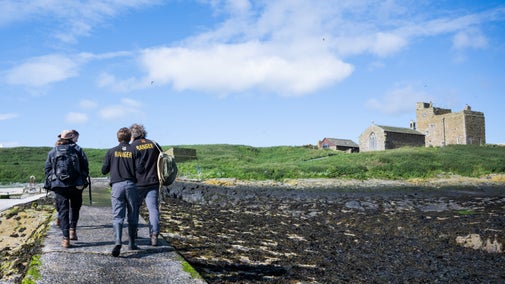
Discover more on the Farne Islands
Find out how to get to the Farne Islands, where to park, the things to see and do and more.

Uncover the history of some of the people who have lived on the Farne Islands over the centuries. Hermits and monks such as St Cuthbert sought solitude and built places of worship here. But many soldiers, lighthouse keepers and even shipwrecked sailors arrived on the Islands too, either by fate or by design.
Born around 634 near Melrose, St Cuthbert spent just over eight years of his life on Inner Farne. First becoming a monk at Melrose Abbey and then Prior of the monastery at Lindisfarne, he retired to Inner Farne as a hermit in 676. It was here that he found the communion with God he so longed for.
Once on Inner Farne Cuthbert built a cell from turf and stone, and a larger guesthouse for visitors – probably on the site of the Fishe House near the jetty. The present complex of buildings occupies the site of Cuthbert's original cell.
Initially Cuthbert was supplied with food from Lindisfarne, but he craved isolation and requested tools and grain to grow his own. It's said that he formed a close relationship with the island's birds, especially the eider duck, which he sheltered in bad weather. They’re still known locally as ‘Cuddy’s’ (or ‘Cuthbert’s’) ducks.
Persuaded by King Egfrid of Northumbria, Cuthbert left his island to become Bishop of Lindisfarne. But after just two years he once again retired to Inner Farne, where he died in March 687. His body was taken to Lindisfarne, where people flocked to pray at his grave and many miracles of healing were reported. Cuthbert was declared a saint in 689.
St Cuthbert would go on to become one of England's most important saints. His eventual resting place of Durham Cathedral became a place of great significance to medieval pilgrims. This led to the formation of the cult of St Cuthbert in the 12th century. His banner was flown in battle and his tomb was visited by thousands of people seeking his aid.
Today his legacy on the Farne Islands lives on through the health of the bird populations, the chapel dedicated to him, and the unique atmosphere that continues to draw many people to the Farnes.

Up until the early 20th century the two lighthouses on the Farne Islands were manned by a succession of keepers. The most well-known keepers of all were the members of the Darling family.
Appointed lighthouse keeper on the outer Farnes in 1795, Robert Darling was in charge of the beacon light on Brownsman for 15 years. In 1805 his son William and his wife Thomasin came to join him.
When the new lighthouse was built on Brownsman in 1810, William and Thomasin brought up their nine children in the cottage attached. William became the principal keeper when his father died in 1815. In 1826 the family moved into the newly built lighthouse on Longstone and William stayed here until he retired in 1860.

The most famous of William and Thomasin Darling’s children was their youngest daughter Grace. She helped her father to rescue survivors from the wreck of the paddle steamer Forfarshire in 1838. Grace became a Victorian celebrity and dozens of artists visited the islands to paint her. A huge sum of money was raised for her benefit, including £50 from Queen Victoria.
Two of Grace’s brothers also became lighthouse keepers. William Darling Junior, the family’s eldest son, was the first keeper at Coquet Island lighthouse in 1841. Meanwhile William Brooks Darling, a younger son, became his father’s assistant on Longstone. The sons swapped positions in 1859 so that William Junior could prepare to take over Longstone when his father retired.
William Darling Junior died in 1869, but his two youngest sons – called Thomas and William – became lighthouse keepers too. The younger William served on Inner Farne from 1875–1877. William Brooks Darling died at Coquet in 1870.

Find out how to get to the Farne Islands, where to park, the things to see and do and more.
Discover how the Farne Islands have proved to be the ideal location for many structures over the centuries, from a monastery and chapels to a pele tower and several lighthouses.

Inner Farne is now closed for landings and will reopen on 1st April 2026. Find out what you might see when you take a boat trip to the Farne Islands, from wildlife such as puffins and grey seals, to centuries-old buildings including St Cuthbert's Chapel.

Find out more about how we care for Farne Islands in Northumberland, from repairing the boardwalks to surveying seals and ringing birds to track their movements.

From landscape gardeners to LGBTQ+ campaigners and suffragettes to famous writers, many people have had their impact on the places we care for. Discover their stories and the lasting legacies they’ve left behind.
